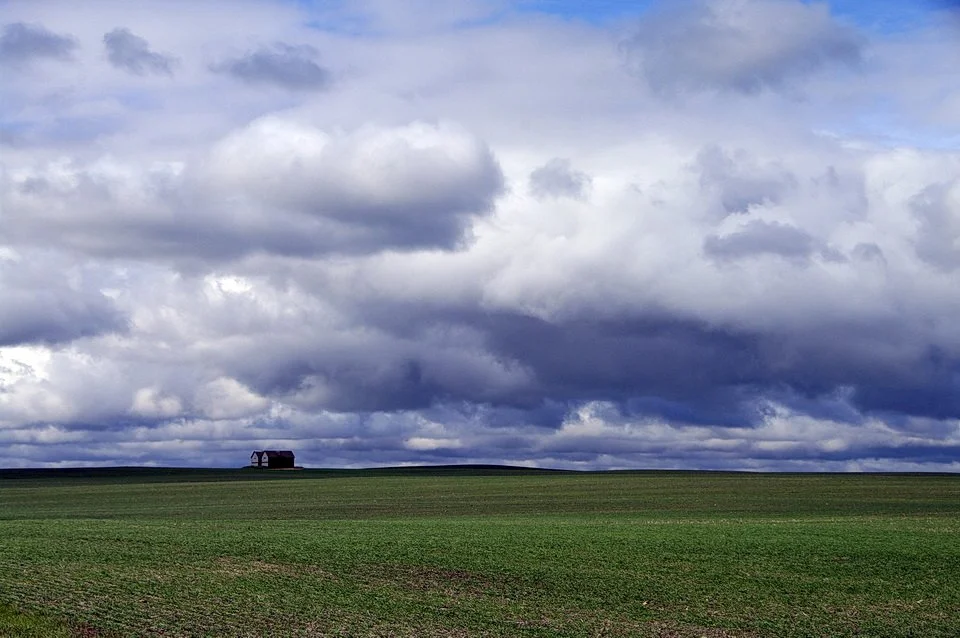Saskatchewan Has A Secret
I watched a travel video about Saskatchewan. The standard jokes were there: “The land is so flat you can watch your dog run away for three days” and “you know that the prairies are pretty much entirely flat. It's great for dog sledding, but not so great for downhill skiing and mountain biking.”
The jokes are unwarranted, even if mildly amusing. I happen to love Saskatchewan because it has many unusual cultural sites and geological features of interest.
Yes, parts of Saskatchewan are flat (Photo 1), but, Saskatchewan has a secret that it does not boast about. Mountains. Yes, Mountains!
Photo 1: Parts of Saskatchewan are definitely flat, as illustrated by this view across the grassland prairies in Gasslands National Park, near Val Marie, southeastern Saskatchewan. Photo by Andy Fyon, July 25/11.
To understand that secret, we have to time-travel back about 1.5 billion years. What do you see? Mountains. Yes, mountains as tall as the Himalayas right in Saskatchewan!
Recall that the outer surface of the Earth, called the crustal lithosphere, where we live, is broken up into a number of rigid plates. Those plates float on, and move about over, a thick zone of plasticine-like mantle rock that comprises most of the deep Earth. Buoyant continents sit like islands on some of those plates. Where those continent-carrying plates collide with each other, during a continent - continent collision, the continents get welded together. Great pieces of the Earth’s crust are compressed, like an accordion, and pushed upwards to create a mountain chain. This type of continent - continent collision created the Himalayan Mountains.
Trans-Hudson Orogeny
What does this have to do with Saskatchewan? About 2 billion years ago, an event took place that created mountains and the heart of the North American continent, called Laurentia. Geologists call that the Trans-Hudson Orogeny or THO for short. During the THO, three smaller continents named the Hearne-Rae craton (northern Saskatchewan), Superior craton (eastern Canada), and Wyoming craton (western United States), and a trapped fragment of microcontinent called the Sask craton, were all smashed together during a continent - continent collision. A huge mountain chain formed along the collision zone and was a defining feature of the ancestral North American Craton of Laurentia, which comprises most of the United States and Canada.
Saskatchewan was a busy place 2 to 1.5 billion years ago, but the THO affected much more than Saskatchewan. North eastward from Saskatchewan, the THO extends across northern Ontario, across Hudson Bay, through northern Quebec, parts of Labrador and Baffin Island, and into Greenland. South from Saskatchewan, the THO and its mountain chain extended through Montana, Dakota, Wyoming, and Nebraska (Photo 2).
Photo 2: The generalized area of surface rock affected and created during the Trans Hudson Orogeny, with an emphasis on the northern extent. Image from: Encyclopedia of Saskatchewan.
Now, 1.5 billion years is a very long time and the mountain chain created during the THO, which was as tall as the Himalayan Mountains, was eroded and worn away by geological processes over the next 1.5 billion years. Only the mountain roots remain. Today, the prairie land hides the roots of this once majestic mountain chain, but you can still see a vestige of the former mountains in northeastern Saskatchewan and in the Black Hills of South Dakota.
Epilogue
I have greatly simplified the story, but, the next time you travel across Saskatchewan, pause in Regina. It may be difficult to imagine the towering mountains that once existed here 1.5 billion years ago because the landscape is so flat (Photo 3), but tip your hat to Saskatchewan’s geological history. Its recent geological history conceals an important mountain forming event that helped stitch together the core of North America. And that is Saskatchewan’s secret.
Photo 3: Another illustration of the flat prairie landscape in southern Saskatchewan, where tall mountains once stood 1.5 billion yeares ago. Photo by Andy Fyon, near Avonlea, Saskatchewan, June 11, 2012.
Dec. 23/21



